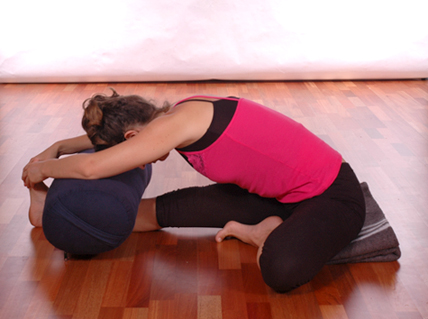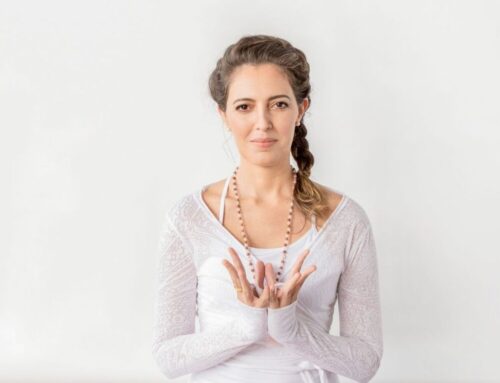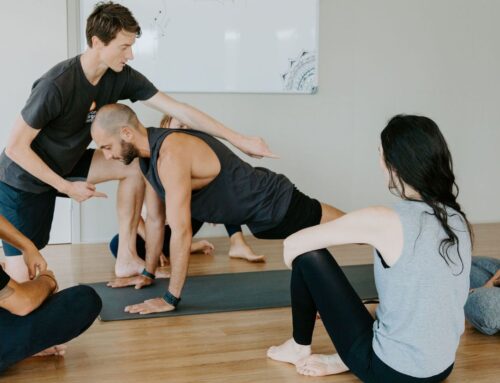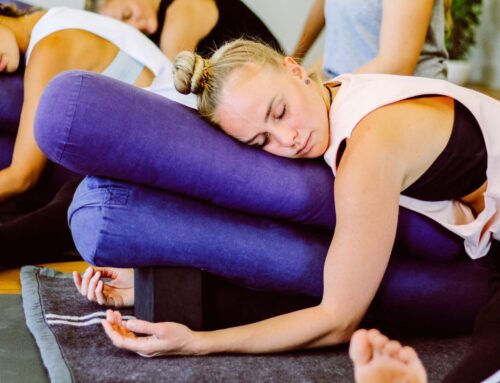“When we’re in our flow, all we have to do is walk across a room to be mesmerizing. We feel confident in ourselves because we’re connected to the earth and in harmony with her rhythms, cycles, and moods”– Gabrielle Roth
Why a feminine approach to yoga?
Yoga is an ancient system created by men for men. Traditionally the practices were passed from male guru to male student. These days however the majority of yoga practitioners and teachers are in fact women. Why then are we persisting in practising yoga like men?
Too many female yoga teachers and students are practising a more masculine, ‘yang’ approach to yoga that is not serving our unique needs as women. Women yoga practitioners would do well to remember that we are inherently cyclical: our hormones are in flux throughout our monthly cycle as well as throughout our life cycle – from menarche through to menopause – which has an impact on us physically and emotionally. Our yoga practice therefore can support us more if it fluidly reflects these changes.
A feminine approach to yoga means moving with, not against our womb as we learn to appropriate the tools of yoga to help us embody a new, non-linear perspective that responds sensitively to the cycles of a uniquely feminine life. In this way, we discover that every time we step on our mat our practice may be different and we are able to enhance our health, wellbeing and connection with our bodies and the cycles of nature.
The stages of a woman’s life
“At menarche a young woman enters her power, throughout her menstruating years she practices her power, and at menopause she becomes her power” – Native American Saying
Moving with your Moon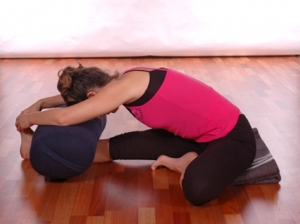
The first and usually longest stage of a woman’s life encompasses the menstruating years. A woman can expect to menstruate approximately 400 times during her fertile life. Most women understand from personal experience just how much their moods and energy levels can fluctuate before during and after their period. This is where learning to ‘move with your moon’ – using your yoga practice to support and mirror the waxing and waning of the uterus as its lining builds and then sheds in an endless cycle – can help us actually fall in love with our bodies and our cycles rather than resent its irrevocable rhythms. For example, when you are menstruating which is a time of natural low-ebb in our energy, a feminine, ‘Moving with the Moon’ approach advocates you avoid certain dynamic postures (including inversions) and to instead practice in a very gentle and restorative way. Whereas when you are ovulating or leading up to ovulation, a time when our energy is building again, you might naturally benefit from a more dynamic practice. There are in fact four energetic phases of our menstrual cycle (corresponding to the phases of the moon) that I suggest we can adapt our practice in quite specific ways. For more information on this you can read my blog, “The Four Energetic Phases of the Menstrual Cycle”.
The added bonus is that if a woman takes the time to adjust her yoga practice (and by extension her expectations of herself in her daily life), so that it responds to the natural, monthly ebb and flow of her energy, she is creating a foundation that will also stand her in good stead to manage the changes and challenges that accompany the other key life stages such as pre-conception, pregnancy, birth, motherhood, and ultimately, menopause.
Creating a Fertile Space
After spending many of her adult years trying not to get pregnant, a woman may get to a turning point where she decides she would actually quite like to get pregnant, and so begins a new stage – pre-conception. This is when the right kind of feminine, fertility-focused yoga can help a woman in so many ways during the journey to pregnancy. You can read more about the benefits of yoga in enhancing fertility in my blog, “On Fertile Ground”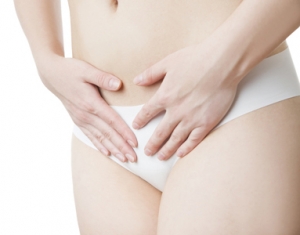
It should be noted that an overly dynamic, ‘yang’ yoga practice could actually be counterproductive as research indicates that vigorous exercise may be connected to greater difficulty in achieving pregnancy. Our focus in our yoga practice during this stage of life is therefore gentle, nurturing yoga that is all about ‘juicing up’ the woman’s natural ‘yin’, femininity; creating a receptive ‘womb space’; nourishing the reproductive organs; and preparing a woman’s body, mind and emotions for pregnancy and motherhood.
Yoga for Two
Once a woman succeeds in her goal of becoming pregnant, or perhaps she unintentionally conceives, she then enters the brief, intense and very sacred stage of pregnancy and birth. Perhaps for the first time in her life, she becomes motivated to actively seek out ways, like yoga, to support and enhance her health and wellbeing in order to give her unborn baby the best chance. For many women, prenatal yoga may be their first introduction to yoga which ushers them into a life-long relationship with this ancient body-mind practice.
The benefits of prenatal yoga are well known. Many doctors and health care practitioners recommend yoga as a safe, effective way to support a woman during her pregnancy as well as to help her prepare for the rigours of birth. Additionally, prenatal yoga can help deepen a woman’s connection with her unborn baby which has flow-on effects for his/her health and wellbeing. “If the communication was abundant, rich and, most important, nurturing, the chances are very good that the baby will be robust, healthy and happy,” writes Thomas Verny, MD in his groundbreaking book, “The Secret Life of the Unborn Child”. For more about the many benefits of yoga during pregnancy read my blog, “Prenatal Yoga: Promoting a Healthy and Joyful 9 Months and Beyond”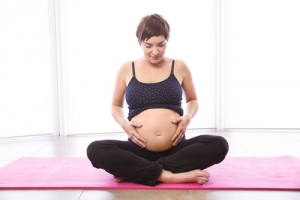
If the woman is able to let go of any ego and yang-focus in her yoga practice during pregnancy and instead approaches it with a gentle, surrendered, feminine focus, she is offered the special opportunity to move into a new understanding: she is now practising yoga for two. In other words, it’s no longer just about her. Her practice then becomes something very sacred in its simplicity and internal focus and may move beyond her mat into her life with an embodiment of a key tenet of yoga philosophy – the idea of ‘ishvara pranidhana’. There are many translations of this concept that appears a number of times in the ancient yogic text, “The Yoga Sutras”. In this context, it means ‘surrender to the universal flow or to the divine’. The right kind of feminine-focused yoga helps her feel more accepting of the many changes to her body and her emotions that she undergoes during pregnancy. It also helps her prepare for the complete surrender that will be required of her during birth (read more about how yoga helps us prepare for birth in my blog “Can Yoga Guarantee an Easy Birth?”). And, the philosophy helps her cultivate a more positive attitude towards the irrevocable changes to her life once she becomes a mother. Ultimately, yoga teaches us about surrender and letting go of any set expectation of how things ‘should’ be during our pregnancy and beyond.
Nurture the Nurturer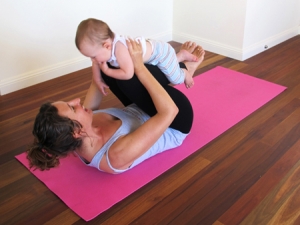
A still somewhat neglected stage of a woman’s life is the period after she has her baby and faces the challenges of new motherhood. A great deal of the attention is placed on the pregnant and birthing woman and the new mother may be forgotten by our society. In addition to the inevitable sleep deprivation of new motherhood, a woman may feel lonely, isolated and anxious in response to her new responsibilities. Her post-pregnancy and birth-body too is in a weakened and vulnerable state. This is where postnatal yoga and the joys of mothers and babies yoga can have such positive benefits for a woman, supporting her during this unprecedented stage of her life in which she ever after becomes responsible for another little being.
The philosophy here is all about ‘nurturing the nurturer’ – rebuilding a woman’s depleted physical and emotional strength and energy so that she can go on giving to her baby and family. Yoga can become a lifeline – a brief sanctuary in her day in which she is given permission to focus just on herself. Or, if it’s mothers and babies yoga, an opportunity to share the joys of yoga with her baby and deepen their bond. ‘Mums n Bubs’ yoga classes provide a much-needed community of other mothers to swap experiences and counteract the isolation that can occur in our nuclear-family structured society. For more about the joys and benefits of ‘mums ‘n’ bubs’ yoga read my blog, “Why Mums n Bubs Yoga”
The Wise Woman
The final major life transition for women is the menopause, or what I like to call ‘the wise woman stage’. For a lot of women this can be a very rocky transition that can span a number of years characterised by multiple, unsettling physical and emotional symptoms.
The time leading up to our final menstrual period, when our body ceases ovulating for good, can span anywhere from 2 – 15 years, and is called the ‘perimenopause’. During the Perimenopause, which is still little understood by many women, our bodies go through a tumultuous hormonal dance in which the normal patterns of our menstrual cycles may become more intense and we may experience a number of vexing symptoms including heavy bleeding, irregular periods, tiredness, depression, irritability and insomnia – to name a few!
Yoga can support a women during this often bewildering stage in which everything again shifts in her life – not only by helping balance her hormones and nourishing her nervous system but also by providing those tools for accepting and surrendering to her changing body and emotions.
If, during our menstruating years, we have been tracing our monthly cycle with a ‘moving with the moon’ approach that adapts our yoga practice to the various phases of our menstrual cycle then we already have a ready template for living that we can now transfer to this new life-stage. It can be beneficial to have at our disposal yoga-tools that support us during an extended or intense premenstrual phase, or distressing bout of heavy bleeding which are common during the perimenopause. Even after menopause when a women no longer ovulates or menstruates, she can continue to practice in a feminine-focused way that follows the phases of the moon. In this way, she is able to stay connected with the echoed-cycles of her feminine body and of nature and therefore maintain an internal rhythm that will help support her as she moves into the ‘Winter’ of her life.
Principles of a Feminine Practice
Threaded throughout these life stages for women are three key principles that can guide us in implementing a nurturing and most importantly, feminine approach to our yoga practice.
Ahimsa
The first of these feminine-yoga principles is ‘Ahimsa’.
“When we refuse to take the time to treat our bodies, emotions, and minds with reverence and love, they will often remind us – not so kindly – by failing to respond when we need them. Our ability to think clearly recedes. We may experience sadness and depression. After a time our lack of ease may allow disease to creep into our life. Then we are obliged to take care of ourselves… It is much more pleasant and fun to do it willingly, before any dis-ease invites itself to your life. Love for yourself is love for all.” – Nischala Joy Devi
Ahimsa is a significant moral precept from the Yoga Sutras. Ahimsa is derived from two words: ‘a’, meaning ‘not’, and ‘himsa’, meaning ‘harm’. It therefore means ‘non-harming’, or literally, ‘non-violence’. From an early age we are inculcated with the idea that hurting others is not socially or morally sanctioned, however, we don’t necessarily learn about the importance of also being gentle with ourselves. For women this is perhaps even more true; we are the nurturers of our society and often are two busy taking care of others to consider that we need to also take care of ourselves. Sometimes we only realise the importance of self-care when we become sick or injured: a warning from our body to prioritise it a little more than we have been doing.
As I have mentioned, it’s very often the case that only once a woman becomes pregnant does she take the idea of self-care seriously, and this is only for the short period of time that she houses her baby in her womb. Far better that she had laid the foundation of self-care well before she became pregnant and also carried this into her new role as mother as an important tool for self preservation.
This concept of self-compassion is the overriding principle for Feminine Yoga, no matter what age or stage we are experiencing. Ideally once we have truly embodied this idea of self-care and self-love we can proactively implement it in our lives so that it becomes a daily habit and not just something we do to try to fix ourselves when something goes wrong. As Liz Koch, psoas expert and somatic therapist suggests:
“What we need is more capacity to build our ability to endure pleasure. What is it to feel good? What is it to allow the system to become more intelligent, more resilient? Most of us don’t have that. We have the idea that we only do something to get us out of pain. We don’t do it because it brings us pleasure; because it brings us a sense of calm, a sense of nourishment. We don’t know how to nourish ourselves, through movement as well as through food. So you’re learning to take care of yourself, to continue this exploration of nourishment.”
Yogic tools that help us embody Ahimsa in our feminine, ‘moving with the womb’ approach to our practice include the relaxation and meditation practices, as well as Restorative Yoga. Ahimsa-in-action involves skilfully tuning in to the changing daily and monthly needs of our body so that we only practice to an intensity that is appropriate for what is going for us at the time. This is where cultivating a home practice rather than always attending group classes can really help us learn to understand and respond sensitively to our own individual needs.
Living some of the key principles offered by yoga philosophy in how we treat ourselves and others off the yoga mat can be another practical way of practising Ahimsa. For example, developing mindfulness around our intentions, thoughts and actions – are they kind, are they necessary? Also, learning to accept ourselves implicitly when we invariably ‘fall down’ and act unkindly or inappropriately towards ourselves or others. Ultimately, our ‘yoga off the mat’ practice in which we set the intention to live as mindfully and gently as possible is very similar to our ‘on the mat’ practice. It is a practice. And that’s the key thing to remember when you fail. Which you will! Just get back on your ‘metaphorical’ mat and begin again. The relentless challenges of motherhood have taught me that one on a very profound level! Forgiveness and letting go of judgement are all ways we can bring more of the nectar of Ahimsa into our daily lives.
Apana
A second key principle of a feminine practice is the idea of ‘Apana’. According to ancient yogic physiology and Ayurveda (the sister-science to yoga) there are five key ‘Vayus’ or ‘energies’ that govern different bodily functions and aspects of our being and they all need to be in balance for our optimal health and vitality. ‘Prana Vayu’ is the energy that resides in the chest and head and governs our inspiration and taking things in, and nourishes the brain and the eyes. The force behind Prana Vayu is upward and propulsive and is generally considered more ‘masculine’ in its quality. ‘Apana Vayu’ is the opposite more ‘feminine’ quality of energy flow that is represented by a downward movement residing in the pelvis, nourishing the pelvic organs. Healthy Apana – the downward movement of energy – is essential in supporting processes such as elimination of our bodily wastes in order to avoid imbalances like constipation or diarrhoea. Apana Vayu is also responsible for eliminating mental and emotional toxins than can help support our whole mind-body health. Specifically for women, the processes of menstruation and birth are governed by the energy of Apana and it is therefore an important governing principle for our work with a more feminine-based yoga practice.
Additionally, because Apana is a grounding energy it can help balance our ‘Vata’ levels. Vata is one of the three main Ayurvedic constitutions that is connected with the air-element. When we have an excess of this Vata energy in our bodies we may feel anxious, ‘spacey’ and ungrounded. It is therefore useful to focus on cultivating Apana Vayu during times of high Vata that can characterise perimenopause or in our premenstrual and menstrual phases of our monthly cycle.
Yogic tools for harnessing the power of Apana and to deepen the therapeutic value of a feminine-focused yoga practice include breathing techniques such as the “Apana Breath” (this is described in detail in my E-book, “The Dark Moon – Nurturing Yoga for Healthy Menstruation” and there is also an accompanying guided audio track to practice along), specific meditation and visualisation practices (again – see my e-book, “The Dark Moon” for an Apana-building script and audio meditation I call “The Primordial Ooze Meditation”), grounding, often floor-based Postures (for example, Baddha Konasana – see diagram below) and sequences like the classical joint-freeing and digestive toning sequence known as ‘Pawanmuktasana’ (read more about this wonderful sequence for women and also watch a video of my women’s yoga version of this sequence here)
Pelvic Circulation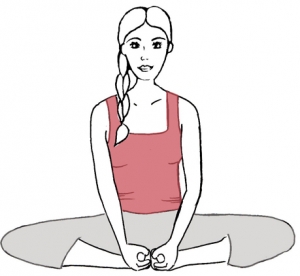
The third guiding principle for a feminine yoga practice is the circulation of both blood and energy around the womb and pelvic area.
The health and vitality of our pelvic organs (ovaries, uterus, fallopian tubes) are greatly improved when there is unimpeded blood flow to this area. In a feminine-focused yoga practice, particularly one in which we are aiming to improve our menstrual health or our fertility, it is important that we opt for yoga postures that encourage this pelvic circulation. We therefore regularly practice what I call the ‘Classical Women’s Postures’ like Baddha Konasana (see diagram) or Upavista Konasana (see diagram) that promote circulation to the pelvic bowl, pelvic floor and vagina. Inversions – both active and more restorative – are also beneficial in bringing fresh blood supply to the pelvic area, as are postures which create a ‘sponge-action’ in the abdominal area such as prone backbends like Salabhasana (the Locust Pose) or twisting postures.
Tight pelvic muscles can restrict the natural, healthy circulation within the pelvis. So, by using breath, relaxation practices, and restorative postures that create space and softness in the pelvic-belly we can help release any accumulated tension in this area.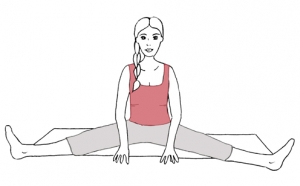
“The quality of energy flow in the female pelvis, including the flow of each ovary, the uterus, and the vagina, impacts on a woman’s overall vibrancy. Like nutrients drawn from the soil that are essential for a plant’s growth, the flow of pelvic energy through a woman’s root determines the vitality of her womanhood.“ – Tami Lee Kent
Not only is it beneficial to promote the blood circulation in our pelvis and lower abdomen but also the flow of energy or ‘Shakti Prana’. ‘Prana’ is the energy, or life-force that moves around our body and ‘Shakti Prana’ is the sacred feminine energy that is present in our lowest two chakras (energy centres) – the Root Chakra at the perineum and the Sacral Chakra in the centre of
the pelvis within the womb. According to Ayurvedic women’s health expert, Maya Tiwari, Shakti Prana works in conjunction
with the energy of Apana to promote the birthing process and the shedding of the uterine lining during menstruation, and is the vital energy source for women. “Shakti prana is the body’s inherent reproductive life force; when it is in a state of balance, it protects the health of the reproductive organs, genitals, womb, belly and breast,” writes Maya Tiwari.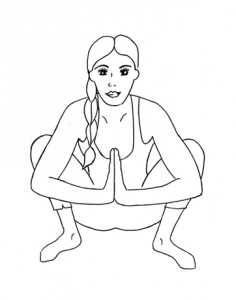
Well known, women’s holistic health expert, Dr Christiane Northrup agrees that the free flow of pelvic energy is vital to a woman’s health: “Fibroids, endometriosis, diseases of the ovaries, and other pelvic disorders are manifestations of blocked energy in the pelvis,” writes Northrup.
Ways to cultivate the free-flowing circulation of our Shakti Prana and even build its power include practising squatting postures and consciously directing the breath and the awareness (using visualisation) to the sacral, pelvic and perineal areas.
My hope is that by sharing these main principles and also pointing out the various stages in our lives when we might need to alter our yoga practice that you are inspired to find your own personal yoga practice that honours your unique needs as a woman no matter where you are in your life’s journey.

Ana will be a lead trainer on her upcoming 80 hour Specialty Women’s Yoga Teacher Training course in Byron Bay, 25 May – 3 June, 2016, which will explore the themes discussed here in greater depth, including adapting yoga for all stages of menstruation, fertility, menopause, and more.
Ana will be a guest teacher on the upcoming Bliss Baby Yoga 100 hr Prenatal and Postnatal Yoga Teacher Training in Byron Bay, 28 April – 6 May, 2016 and facilitate a 1-Day Level 1 Restorative Yoga Teacher Training in Byron Bay, 7th May 2016.
